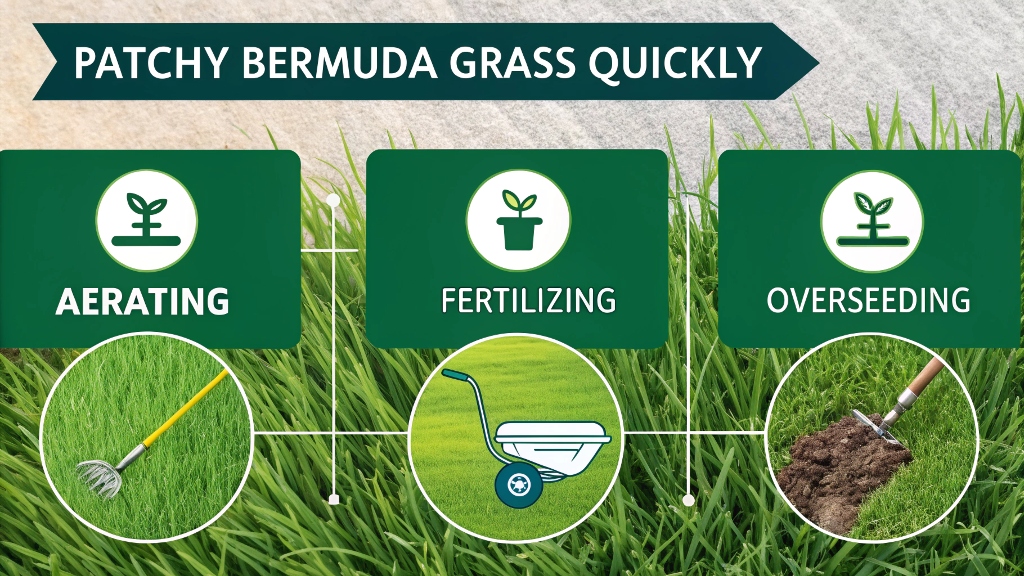It’s frustrating to see bare spots or uneven patches in your patchy Bermuda grass, especially after all your hard work. Whether it’s from foot traffic, poor watering, or the wrong fertilizer, patchiness can ruin your yard’s curb appeal.
Good news? You can fix it—and overseeding is one of the best ways.
Overseeding breathes new life into worn-out grass by filling in thin spots with new growth. Done right, it gives you a fuller, greener, and healthier lawn that lasts through the season.
If you’re ready to bring your Bermuda grass back to life, you’ve come to the right place. In this guide, we’ll walk through how to overseed a patchy Bermuda lawn from prep to watering, with real tips that work.
And if you’re looking for reliable lawn care help, take a moment to explore Boyers Lawn Care for services tailored to your lawn’s unique needs.
Why Overseeding Works for Bermuda Lawns
How to naturally treat your lawn is a common question among homeowners striving for a healthy green space. One proven method is overseeding Bermuda grass, especially when it’s looking sparse or uneven.
Bermuda grass is tough and fast-growing, but even the best lawns wear down. Overseeding gives it the boost it needs without starting from scratch.
Here’s why it works:
- Boosts density: New seed fills bare or thin areas, giving your lawn a thick, lush appearance.
- Improves color: Fresh grass adds vibrant green color, especially in areas damaged by sun or foot traffic.
- Enhances disease resistance: A dense lawn naturally fights off weeds and pests better.
According to a turfgrass study by the University of Georgia, properly overseeded Bermuda lawns show up to 35% improved turf coverage in just 6 weeks compared to untreated lawns.
From my own experience as a homeowner in a warm southern climate, I struggled with patchy Bermuda grass near walkways. I tried patch kits and even fertilizer, but the real game-changer was overseeding. Within weeks, the spots filled in and my lawn looked better than ever.
If you’ve got bare patches, don’t give up. Overseeding might be your easiest fix yet.
Step 1: Choose the Right Time to Overseed
Timing is key with Bermuda grass. Unlike cool-season grasses, Bermuda is a warm-season turf. That means you’ll get the best results if you overseed during its peak growing period.
The Best Time:
- Late spring to early summer is ideal, when soil temperatures reach 65–70°F consistently.
- Avoid late summer or fall, as the new grass won’t have time to establish before dormancy.
Additionally, keep in mind:
- Overseeding too early leads to seed rot or poor germination.
- Overseeding too late results in weak root systems before cold weather.
Pro Tip: Use a soil thermometer to check temperatures before seeding. If the soil feels cool in the morning, wait a week or two.
Timing really does matter—I once tried overseeding too early in March. Cold snaps killed most of the new growth, and I had to reseed. Lesson learned: let the soil warm up first.
Step 2: Prepare Your Lawn for Seeding
A good seedbed is crucial for successful overseeding. That means removing debris, thinning out old grass, and ensuring the soil is ready to receive the new seed.
Follow these steps:
- Mow low: Cut your Bermuda grass down to 1–1.5 inches. This helps light reach the soil and allows seed-to-soil contact.
- Bag clippings: Don’t leave cut grass behind. Bag or rake them up so they don’t smother new seeds.
- Dethatch if needed: Thatch thicker than ½ inch should be removed using a dethatcher or hard rake.
- Loosen soil: Use a rake or aerator to gently open the soil surface.
- Remove debris: Rocks, sticks, or dead leaves must go—they block seed contact.
According to the National Association of Landscape Professionals, proper soil preparation can increase seed germination rates by up to 40%.
So, take your time prepping. Skipping this step can lead to patchy growth and wasted seed.
Step 3: Pick High-Quality Bermuda Grass Seed
Not all Bermuda seed is created equal. Choosing the right type ensures better germination, faster growth, and disease resistance.
What to look for:
- Certified seed: Look for “Certified Bermuda” or varieties like Princess 77, Yukon, or Arden 15.
- Seed purity: Aim for seed with 90% purity or higher.
- Germination rate: Choose seed with at least 80% germination.
- Blends for sun and traffic: If your lawn gets a lot of use, consider traffic-tolerant mixes.
You can expect to pay more for quality seed, but the results are worth it. Cheap seed often contains fillers or weed seeds.
I once bought a discounted bag from a home store. It barely sprouted, and what did grow was weedy and uneven. Spending a little more the second time made a huge difference.
Look for seed from trusted brands and suppliers. You’ll save time and get better results.
Step 4: Apply the Seed Correctly
Now that your lawn is prepped and your seed is ready, it’s time to apply.
How to do it:
- Use a broadcast spreader: It ensures even distribution and avoids clumps.
- Spread seed in two directions: Go north–south, then east–west for full coverage.
- Recommended rate: Use about 1–2 pounds of seed per 1,000 square feet for overseeding Bermuda.
Optional but helpful:
- Apply starter fertilizer: Choose one high in phosphorus (e.g., 10-10-10) to promote root development.
- Lightly rake: After seeding, lightly rake to cover seed with ¼ inch of soil.
- Roll it in: Use a lawn roller for seed-to-soil contact.
Don’t bury the seed too deep. Bermuda seed is tiny and needs sunlight to germinate.
Step 5: Watering Makes or Breaks It
Watering is where many DIY overseeders go wrong. You must keep the soil consistently moist during the germination phase.
Watering schedule:
- First 7–10 days: Light water 2–3 times daily to keep the topsoil moist.
- After sprouting: Reduce to once daily for 1–2 weeks.
- After 3 weeks: Water deeply 2–3 times per week to encourage strong roots.
Too much water leads to rot. Too little, and the seeds dry out.
Use a sprinkler with a fine mist setting to avoid washing seeds away. Avoid walking on the lawn until the grass is at least 2 inches tall.
In my case, a timer system saved me. Setting automatic light watering intervals kept everything evenly moist and sped up growth.
Step 6: Care for New Grass Until It’s Established
Once your grass has sprouted, you’re not done yet. The first month is crucial for helping the new Bermuda thrive.
Do this:
- Mow after 3–4 weeks: Wait until the grass reaches 2–3 inches. Use a sharp blade and mow on a high setting.
- Fertilize again: After 4 weeks, apply a nitrogen-rich fertilizer to support top growth.
- Control weeds: Hand-pull weeds early. Avoid herbicides until the new grass is 6+ weeks old.
Avoid:
- Heavy foot traffic
- Mowing too short
- Overwatering or underwatering
Following this plan helps ensure the seed takes root and blends into your existing lawn naturally.
Read More Also: Why Neutral Colors Are the Timeless Choice for Home Interiors
Conclusion
Overseeding a patchy Bermuda lawn isn’t hard—it just takes a bit of planning and patience. When done right, your lawn will look thick, vibrant, and healthier than ever.
To recap:
- Overseed when soil is warm (65°F+)
- Prep the lawn by mowing and dethatching
- Use high-quality seed
- Water often—but not too much
- Follow up with care and gentle mowing
Have questions or want to share your lawn journey? Leave a comment below! Or share this article with a friend who needs a lawn upgrade.
Read More Also: The Enduring Appeal of Stucco Walls: A Comprehensive Guide
FAQs
How long does Bermuda grass take to grow after overseeding?
Most seeds germinate in 7–14 days. Full results appear in 4–6 weeks with proper watering.
Can you just throw Bermuda seed on the lawn?
No. Seeds need soil contact to germinate. Always prep the area and rake lightly after spreading.
What fertilizer should I use when overseeding Bermuda?
Use a starter fertilizer with balanced nutrients (e.g., 10-10-10) during seeding, then nitrogen-rich after 4 weeks.
Is it okay to walk on the lawn after overseeding?
Avoid walking on the lawn until new grass is at least 2 inches tall—usually after 2–3 weeks.
How often should I overseed Bermuda grass?
Once a year is usually enough, especially in spring. Overseeding more often can lead to uneven growth.






